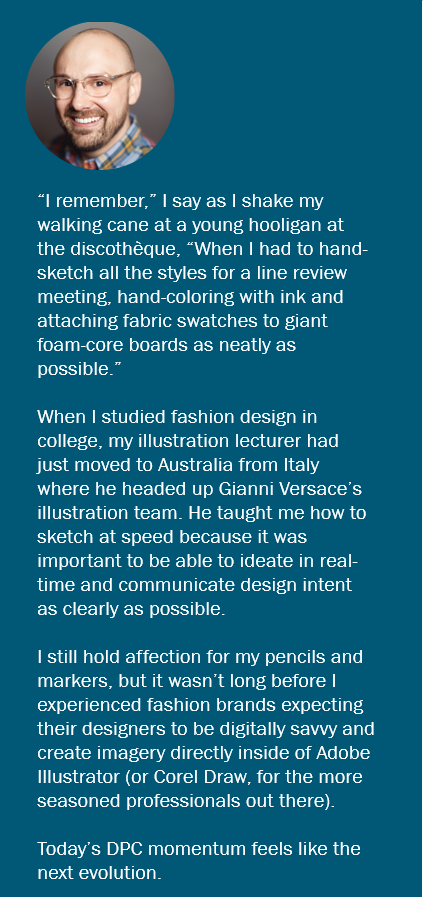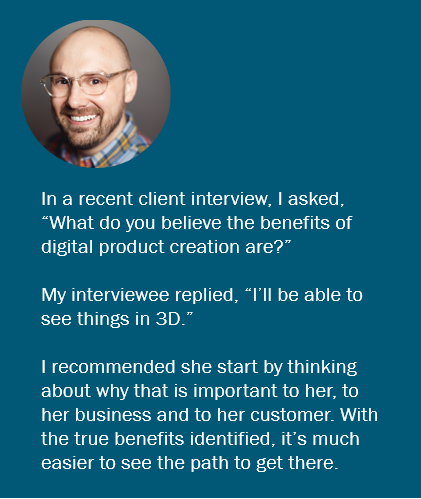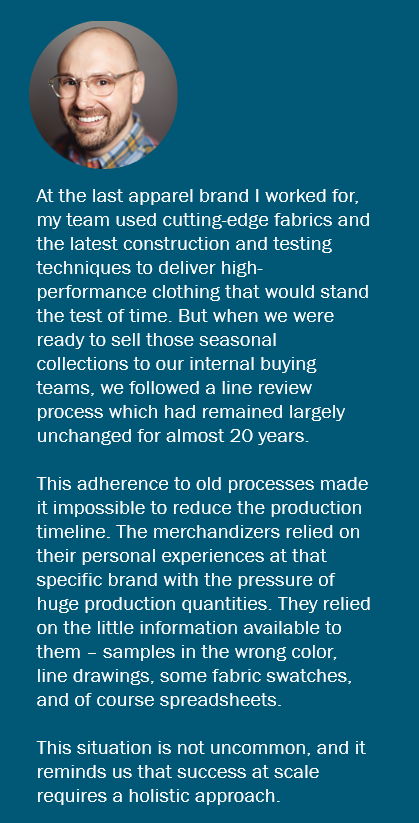Digital Product Creation: Turning Experiments into Experiences
3D and digital product creation (DPC) are top of mind for most retailers and brands today. DPC encompasses a wide range of recent innovations in 3D parametric and polygonal modeling, generative design and procedural functions, additive manufacturing, and mixed-reality experiences.
But this isn’t the first time we’ve had a paradigm shift in the way we digitally create, make and sell apparel and footwear. Let’s look at what’s causing this momentum and how companies can address common challenges so they can move from experimenting with DPC to scaling and maximizing the significant benefits.

A Different Kind of Exactly the Same?
When working with retail, footwear and apparel companies, it often seems that the challenges of the 1990’s that lead companies to invest in digital programs for designers still exist. It can feel as though not much has changed in 20 years; we need better visuals to make informed decisions, sustainable and innovative production techniques to elevate our brand above our competitors, and faster feedback or prototyping to get us to market faster.
But a lot has changed. Beyond the internal driving forces above, consumer influence has surged – a result of today’s always-on lifestyle that puts the world at their fingertips. As 5G rolls out, not only will we be able to stream the latest episodes of Black Mirror faster than ever before, we’ll also see a spike in consumer expectations.
Think front and back-view photography is going to cut it? Think again.
On-demand, photo-realistic, 4K video and 3D configurators are about to drive a new reality for personalization. As brands adopt 3D models for their online retail experiences, consumers can view products virtually in a variety of lighting environments – for example, daytime, nighttime, in-store or in a car. These simulations are an easy way to offer rich online retail experiences.
And that’s just as example of where the benefit starts. Today, agile teams introduce new business models that automate the Bill of Materials (BOM), tech pack, and prototype phases with dynamic product lifecycle management (PLM) integrations attached to 3D design tools. Once handed over to marketing, companies create virtual stores and showrooms that empower refined data-driven assortments and visual merchandizing. Photo-realistic product representations enable better communication between developer and manufacturer while more informed decision making enables a tighter timeline to get to market faster.
The possibilities are exciting, but while 3D may be the current source of buzz, digital product creation is not just about 3D modeling. It’s a common misconception that implementing just one 3D tool will provide incredible speed, efficiency and benefits with minimal training for designers. And this is just one of the common pitfalls that makes it hard for retailers and brands to scale DPC initiatives.
Proof of Concept Purgatory – It’s a Real Place
Most companies are making some sort of investment in DPC. At this point, companies recognize the importance of DPC to their future and are making strides to build those capabilities, even if at a modest pace.

In a recent survey on DPC maturity, conducted by Kalypso, Indiana University’s Kelley School of Business, and PI Apparel, found that average industry maturity is relatively low, with companies struggling to move beyond experimentation to a meaningful proof of concept (POC) and ultimately to value at scale.
What’s happening here? Significant obstacles are difficult to envision with new technology, especially when companies fail to recognize that even a POC requires a holistic cross functional strategy, a solid data foundation, different talent and skills, and new or updated processes.
On top of that, with all the new technology available, it’s difficult to understand the best starting point for a specific company’s business challenges and growth plans. Should you start with parametric 3D cloth simulations? What if you want fabric to look more realistic on your website? Which tools will automate the artwork application process for your manufacturers? Can you get insights from your 3D design data to inform a better product?
A POC with no direction on how it affects the people, the work, the business or the consumer will spiral into confusion followed by frustration. Designers and developers start to push back against technology altogether and the benefits seem further and further out of reach.
Tips to Achieve Meaningful Benefits from DPC – from POC to Scale
To achieve meaningful benefits from investment in DPC, retailers will need to disrupt business models that they have held on to for the past 5, 10, or even 20 years. The DPC maturity research from Kalypso shows gaps between leaders in DPC, who are making meaningful shifts to POCs and scale, and those that are stuck in a loop of constant experimentation.
 Because DPC has the potential to drive significant product development transformation, at some point it requires a vision, strategy, senior executive sponsorship, business case and roadmap in order to be successful.
Because DPC has the potential to drive significant product development transformation, at some point it requires a vision, strategy, senior executive sponsorship, business case and roadmap in order to be successful.
Five Tips to Break Out of POC Purgatory
- Identify a case for change that resonates with your business leaders and core teams.
- Understand and communicate that technology should support the solution, not provide the solution. A holistic solution to a business challenge should consider how people will need to change and adapt to a new way of working. Creative professionals require context and, most importantly, a healthy vision that they can buy into.
- Prioritize use cases specific to your business. For example, if your business isn’t currently prepared to manufacture personalized products, investing time to create a digital configurator might pull the focus away from use cases that would drive more near-term value. And if you’re not ready to scale as a result of a proof-of-concept or new initiative, you could be investing in technology that will be outdated when you are ready.
- Establish a governance structure to help keep teams in check, provide an avenue for escalating challenges, and create focused teams so that large groups aren’t spinning on key issues and draining resources.
- Create a realistic business model with inputs from key financial advisors and influences. Your business will be measured against this performance, so getting cross-functional buy-in to financial drivers is critical.
Consumers expect their digital lives to be delivered in an agile way, so retailers and brands must react similarly, remaining nimble and agile as you seek to align technology and talent. Time will tell, but those that are ultimately most successful with DPC will be those that view it as comprehensive initiative with an approach that includes strategy, people, technology and process. Be prepared to fail, learn, and adjust.
Learn More
Research Results: Digital Product Creation Maturity in Retail, Footwear & Apparel
Eight Common 3D Digital Product Creation Pitfalls and How to Avoid Them
